Disclosure: This article contains affiliate links. We may earn a commission from purchases at no extra cost to you, which helps our travel content.
Standing at 5,200 meters above sea level, with the world's highest peak commanding the horizon, I found myself contemplating not just the geological marvel before me, but the remarkable journey required to reach this point. The Tibetan approach to Everest Base Camp offers a perspective quite different from its Nepalese counterpart—one that demands careful planning, particularly regarding transportation. After three visits spanning different seasons and political climates, I've compiled this comprehensive transportation guide to help fellow travelers navigate the logistical complexities of reaching one of Earth's most magnificent viewpoints.
Understanding the Permit System: Your First Transportation Hurdle
Before any wheels turn toward Everest, you must navigate Tibet's complex permit system—a bureaucratic ecosystem as intricate as the region's alpine biomes. As of my most recent visit, foreign travelers require a Tibet Travel Permit, an Alien's Travel Permit, a Military Permit, and a Border Pass specifically for the Everest region. These documents function as your transportation enablers, without which movement through Tibet is impossible.
The Tibet Travel Permit must be arranged through a registered Tibetan tour agency at least 15-20 days before your arrival. This permit allows you entry into Tibet and travel to Lhasa. The additional permits for Everest are typically arranged by your tour operator once you're in Tibet. Remember that these permits dictate not only where you can go but how—independent travel is not permitted, and your transportation must be arranged through licensed operators with Chinese drivers.
I've found that agencies with scientific expedition experience often provide more comprehensive logistical support. During my research trips documenting high-altitude lichens, I've relied on satellite communicator for emergency communications in remote areas where cellular networks are nonexistent.
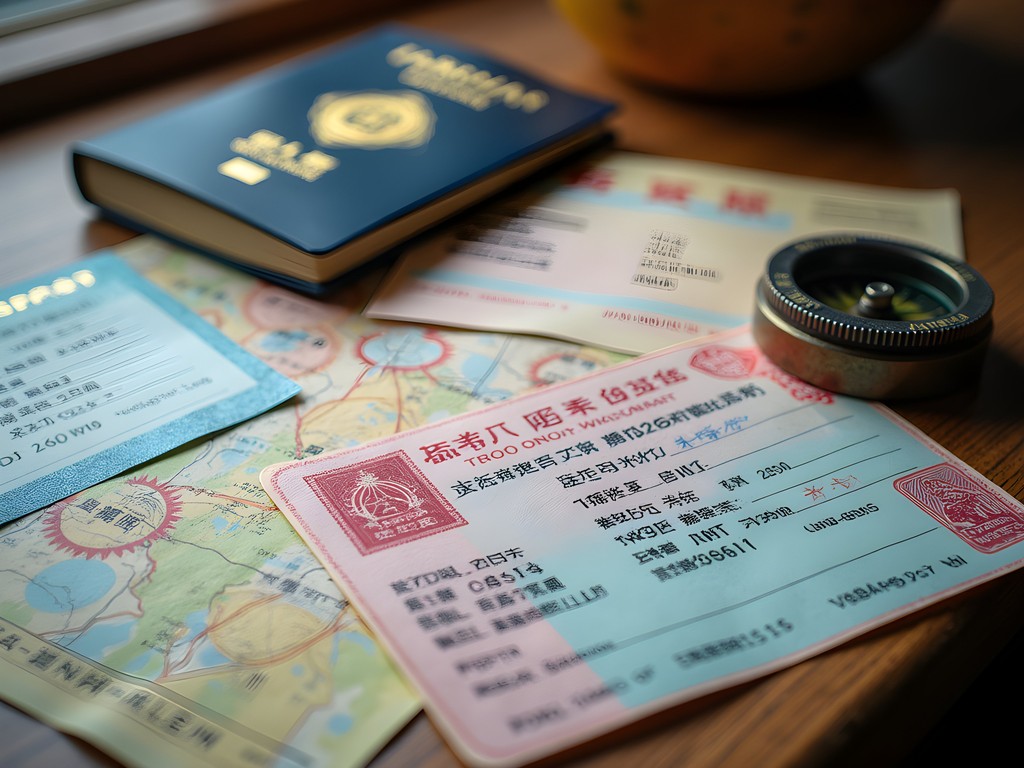
💡 Pro Tips
- Book your Tibet tour at least 3 months in advance during peak season (April-May, September-October)
- Keep digital and physical copies of all permits accessible throughout your journey
- Confirm your tour operator has recent experience with the Everest region, as regulations change frequently
The Lhasa to Tingri Route: Acclimatization Through Transportation
The journey from Lhasa (3,656m) to Tingri (4,300m) serves a dual purpose: transportation and physiological adaptation. This 600km route traverses the Tibetan plateau, crossing several high mountain passes that gradually expose your body to increasing altitudes—a critical process for preventing acute mountain sickness (AMS).
Most tour operators follow a 5-7 day itinerary from Lhasa to Tingri, stopping at Gyantse (3,977m), Shigatse (3,845m), and sometimes Sakya (4,280m). These stops aren't merely cultural experiences; they're calculated acclimatization points. As a biologist, I'm fascinated by how our bodies adapt to decreasing oxygen availability—at Everest Base Camp, oxygen levels are approximately 50% of those at sea level.
Your transportation vehicle becomes your acclimatization chamber. Most tours use Toyota Land Cruisers or similar 4WD vehicles that accommodate 3-4 travelers plus a driver and guide. For my research expeditions, I've found that maintaining proper hydration is critical at high altitudes, so I never travel without my insulated water bottle which keeps water from freezing overnight at high-altitude stops.
The road conditions vary dramatically—from smooth highways near Lhasa to rough dirt tracks approaching Tingri. The Friendship Highway (China-Nepal Highway) forms the backbone of this route, offering remarkable vistas of Yamdrok Lake, Karola Glacier, and eventually, Everest itself.

💡 Pro Tips
- Request window seats on the vehicle's right side when heading west for the best mountain views
- Plan for an extra acclimatization day in Shigatse if you're sensitive to altitude changes
- Pack motion sickness remedies—mountain roads feature countless switchbacks and rough sections
Tingri to Everest Base Camp: The Final Approach
The 120km journey from Tingri to Everest Base Camp represents the most challenging transportation segment. From Tingri (4,300m), you'll climb another 900 vertical meters to reach EBC (5,200m). In recent years, Chinese authorities have implemented significant changes to this final approach.
Prior to 2019, private vehicles could drive all the way to Rongbuk Monastery and the tourist base camp. Now, all visitors must transfer to the official eco-bus at Tashi Dzom—a small settlement about 20km from EBC. This electric bus service was implemented to reduce emissions in the sensitive alpine environment, a conservation measure I wholly support despite adding complexity to the journey.
The eco-buses operate from approximately 9am to 9pm during peak season, with reduced hours during winter. A round-trip ticket costs about 120 Yuan per person (as of my last visit). These buses can be crowded during peak times, and the schedule somewhat unpredictable, so patience becomes essential.
For this final leg, I recommend wearing your high altitude gloves even on sunny days. The temperature drop can be sudden and severe at these elevations, especially when winds pick up in the afternoon. My scientific background has taught me to respect alpine environments—at 5,200m, UV radiation is significantly more intense than at sea level, and the thin air provides little insulation against temperature fluctuations.
Once at EBC, accommodation options are limited to the tent guesthouses near Rongbuk Monastery, where basic heated tents with simple beds provide shelter. No private vehicles are permitted to stay overnight at EBC itself.
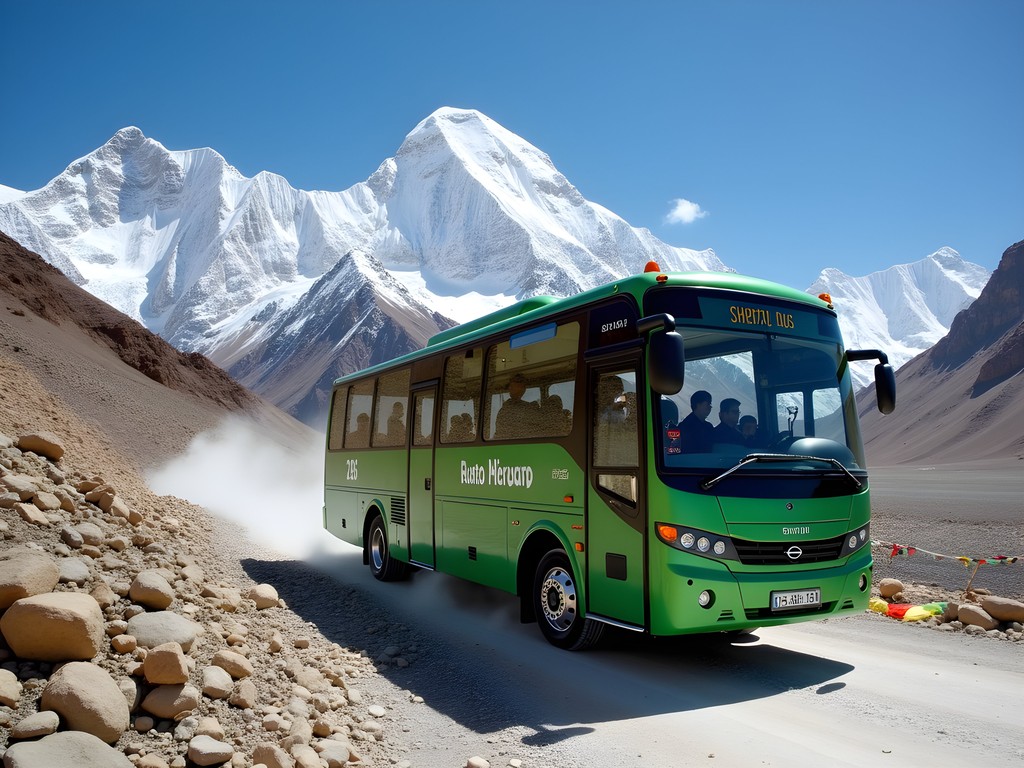
💡 Pro Tips
- Arrive at the eco-bus station early in the morning to maximize your time at EBC and avoid afternoon winds
- Carry sufficient cash for the eco-bus as card payments are not accepted
- Book your tent accommodation at Rongbuk in advance during peak season (April-May and September-October)
Alternative Transportation Options: For Different Budgets and Timeframes
While the standard Land Cruiser tour is the most common approach, alternative transportation options exist for different budgets and preferences. These alternatives each present unique advantages and challenges worth considering.
Private Chartered Vehicle: For families or small research groups like mine, chartering an entire vehicle provides flexibility for impromptu stops—invaluable when I'm documenting alpine plant adaptations or cultural practices. Expect to pay a premium of 30-40% above the standard tour price, but gain the ability to linger at photogenic spots or interesting ecological zones.
Group Tour Bus: Large group tours using 20-30 passenger buses offer the most economical transportation option, often 30% less expensive than standard tours. However, these larger vehicles cannot access some of the rougher roads, potentially limiting your experience. They also follow rigid schedules that allow little flexibility for acclimatization or exploration.
Bicycle Expeditions: For the athletically inclined with significant high-altitude experience, specialized bicycle expeditions from Lhasa to EBC represent the ultimate challenge. These guided cycling tours typically take 20-25 days and require exceptional fitness and proper equipment. During my research on high-altitude adaptation, I observed these cycling groups using altitude training masks during preparation, which can help condition respiratory muscles for the oxygen-scarce environment.
Motorcycle Tours: Guided motorcycle tours have emerged as an option for adventurous travelers. These tours use Royal Enfield Himalayans or similar models suited to rough terrain. Participants must have significant motorcycle experience and international driving permits. The freedom of open-air travel provides an unparalleled connection to the landscape, though at the cost of increased exposure to elements and dust.
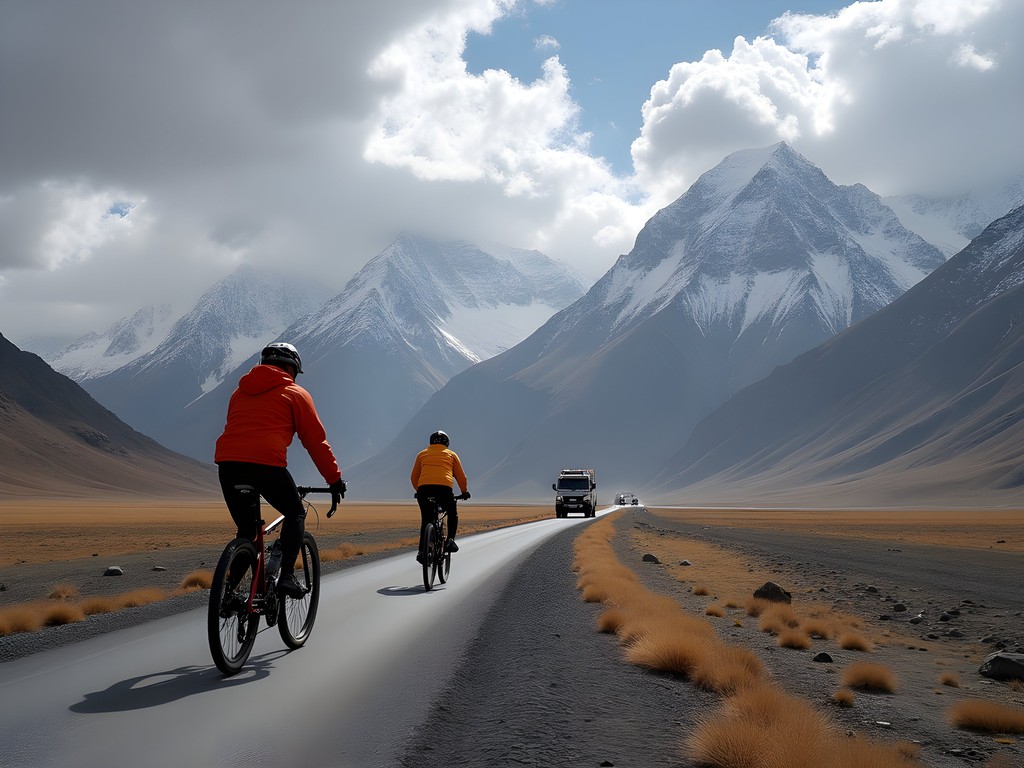
💡 Pro Tips
- Budget travelers should book group tours 4-6 months in advance to secure the best rates
- Cycling expeditions require at least 3 months of specific high-altitude training before departure
- Consider combination transportation packages that use different vehicles for different segments to optimize both comfort and access
Packing Considerations for High-Altitude Transportation
The transportation environment between Lhasa and EBC demands specialized packing considerations. Unlike standard travel, you'll be spending extensive periods in vehicles at high altitudes, often far from services or supplies.
Vehicle space is at a premium, particularly in the standard Land Cruiser setup. Pack efficiently using compression bags, and keep essentials accessible without major unpacking. I organize my gear in a compression packing cubes system that separates items by temperature range and function, allowing quick access to appropriate layers as conditions change.
The altitude affects more than just your body—it impacts your equipment too. Electronic batteries drain faster in cold, high-altitude environments. I carry a solar power bank that recharges during our daytime drives through the intense Tibetan sunlight, ensuring my research equipment and communications devices remain operational.
Vehicle sickness can become more pronounced at altitude, even for those not typically susceptible. Ginger candies, pressure-point wristbands, and prescription medications are worth considering. Sitting in the middle of the vehicle with a view of the horizon can help minimize symptoms.
Finally, remember that your transportation is also your lifeline. While admiring the pristine alpine environment through your vehicle window, you're also dependent on this mechanical system for survival in one of Earth's most extreme environments. Respect your driver's decisions regarding routes and timing—their experience navigating these challenging roads is invaluable.

💡 Pro Tips
- Pack a small day bag with essentials that stays with you in the main cabin rather than accessing the trunk frequently
- Bring a reusable mug for hot drinks—drivers often carry thermoses of tea which provide both hydration and warming comfort
- Include wet wipes and hand sanitizer as roadside facilities are basic at best
Final Thoughts
The journey to Everest Base Camp via Tibet is as much about the transportation experience as it is about the destination. Each segment of this route—from navigating permit requirements to the final eco-bus approach—forms part of a carefully orchestrated acclimatization process that prepares your body for the thin air at 5,200 meters. As a biologist who has studied high-altitude adaptations, I've come to appreciate how this gradual transportation progression mimics the methodical pace of scientific inquiry itself.
Whether you choose the standard Land Cruiser experience, opt for the economical group tour, or challenge yourself with a cycling expedition, remember that transportation in Tibet is never merely about moving from point A to B. It's about respecting natural thresholds, both geological and physiological. The Tibetan approach to Everest offers unparalleled vistas and cultural encounters that complement the majesty of Chomolungma (Mount Everest) itself.
As you plan your own journey, consider not just how you'll reach EBC, but how your transportation choices will shape your experience of this remarkable landscape. The road to the roof of the world demands patience, preparation, and respect—qualities that will serve you well not just in reaching your destination, but in truly appreciating why it's worth the journey.
✨ Key Takeaways
- Allow 5-7 days for the Lhasa to Tingri journey to properly acclimatize
- All foreign travelers must arrange permits and licensed transportation through registered Tibetan tour agencies
- The final approach to EBC now requires transfer to official eco-buses at Tashi Dzom
- Transportation timing is crucial—spring (April-May) offers the clearest views of Everest while avoiding monsoon season
📋 Practical Information
Best Time to Visit
Spring (April-May) and early autumn (September-October)
Budget Estimate
$1,800-$3,000 per person for a standard 12-14 day tour including transportation
Recommended Duration
Minimum 12-14 days from Lhasa to EBC and back
Difficulty Level
Challenging




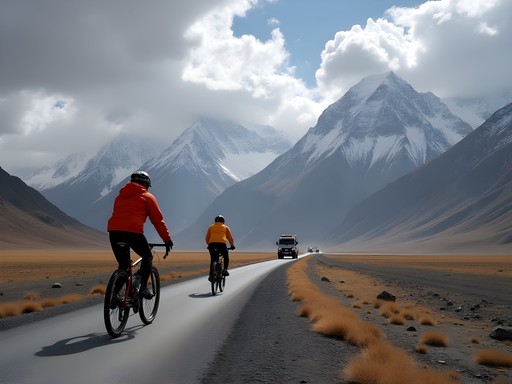
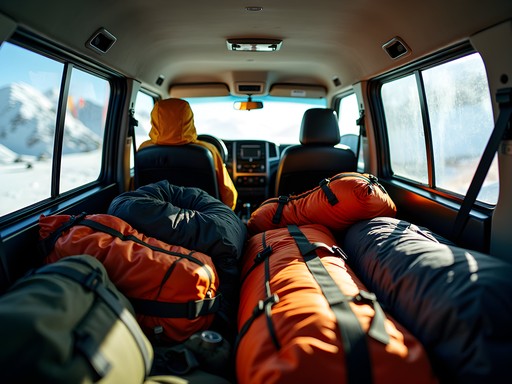





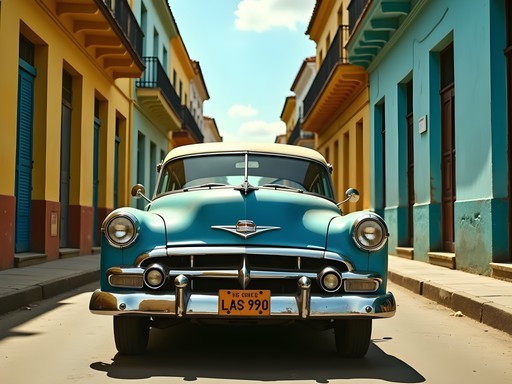

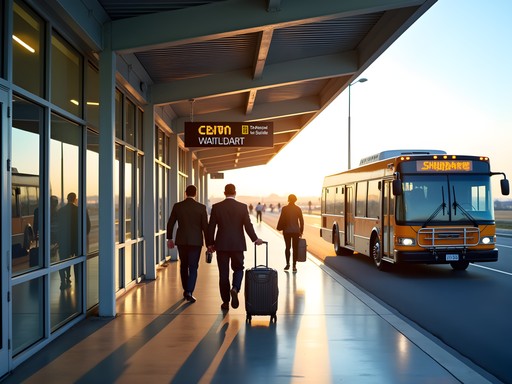


Comments
globeway
OMG this is exactly what I needed! Heading to Tibet next spring and was so confused about how to get to EBC. Bookmarking this guide!!!
cityperson
The section about acclimatization through transportation is so important! When we did this trip, we met people who rushed from Lhasa to EBC too quickly and got terrible altitude sickness. The gradual approach with stops in Shigatse and Tingri made all the difference for us. Also found that having a proper altitude sickness medication like Diamox was essential. My pulse oximeter was super helpful for monitoring oxygen levels throughout the journey.
luckymaster
Is it possible to do this trip solo or do you have to join a tour group?
cityperson
When I went in 2023, foreigners had to be with a guide - it's mandatory for Tibet. You can't just rent a car and drive yourself.
Taylor Hassan
Cityperson is right - independent travel isn't permitted for foreigners in Tibet. You need to book through a licensed tour operator who will arrange your Tibet Travel Permit and guide.
escapeadventurer
Those photos of the Friendship Highway are incredible! Can't wait to see this for myself someday.
Haley Hamilton
This brings back memories! I did this route in 2023 and the transportation logistics were definitely the trickiest part. We hired a Land Cruiser from Lhasa all the way to EBC which was pricey but worth every penny. The driver knew exactly where to stop for the best views and oxygen breaks. One thing I'd add is that the road conditions after Tingri can be rough depending on the season - our driver had to navigate some serious washouts in late summer. Also found that having a quality sleeping bag was essential at EBC as temperatures dropped dramatically at night even in our heated accommodation. Taylor, did you find the altitude affected you much between Lhasa and EBC?
rednomad
Great post! How strict are they about the permits? Can you get them last minute or do you absolutely need to plan months ahead?
Taylor Hassan
Thanks for asking! Definitely not a last-minute thing - permits require at least 3-4 weeks processing time, and during peak season I'd recommend applying 2-3 months in advance. The Chinese authorities are extremely strict about this.
rednomad
Good to know, thanks! Was hoping to be spontaneous but sounds like that's not the move for Tibet!
sunnylover
Great guide Taylor! We did this trip last year and found the acclimatization schedule absolutely crucial. Don't rush it! We spent two full days in Lhasa (3,600m), then one in Shigatse (3,800m) before heading to Tingri. Even with that careful planning, half our group still felt the altitude at EBC. Definitely bring layers - the temperature difference between daytime and night was shocking. And the road from Tingri to EBC gets super bumpy toward the end!
springlover
OMG those photos are absolutely stunning! I've been dreaming about seeing Everest up close forever. This guide is exactly what I needed! Did you find it super cold at base camp? Wondering what kind of layers to pack.
islanddiver
Not the author but I went in September and it was FREEZING at night, like -10°C (14°F). Definitely pack serious winter gear even in summer!
springlover
Whoa, that's way colder than I expected! Thanks for the heads up. Time to invest in better gear than I planned!
Frank Carter
This brought back memories of my Tibet EBC trip in 2023! The transportation aspect is often overlooked but absolutely critical. We hired a Land Cruiser from Lhasa which gave us flexibility to stop at Yamdrok Lake and Gyantse Kumbum on the way. One tip I'd add: if you're prone to altitude sickness, consider extending your stay in Shigatse before pushing on to Tingri. Those extra 24 hours made all the difference for our group. I also found my pulse oximeter incredibly useful for monitoring oxygen levels throughout the journey. Taylor, your breakdown of the permit system is spot on - navigating that bureaucracy was harder than the actual trek!
sunnylover
Frank - did you book your Land Cruiser in advance or find one in Lhasa? Trying to decide between private transport vs joining a tour.
Frank Carter
We booked through a Lhasa-based agency about 3 months in advance. Much easier than finding one on arrival, especially since you need a driver with permits to enter the EBC zone. Happy to recommend our company if you DM me!
globeone
How strict were they with the permits? Planning for next summer!
Taylor Hassan
Very strict - they checked at multiple points. Make sure everything is arranged well in advance through a licensed operator. The permit situation can change quickly too, so stay updated!
Venture X
Premium card with 2X miles, $300 travel credit, Priority Pass